by Gregory Kable
Part Two: America and the World, or My Time of Day
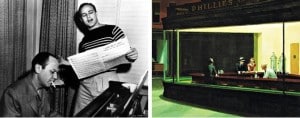 |
| Frank Loesser rehearsing Marlon Brando and Edward Hopper’s poignant Nighthawks (1942). (www.mtishowspace.comwww.mtishowspace.com) (www.edwardhopper.net) |
My time of day is the dark time
A couple of deals before dawn
When the street belongs to the copAnd the janitor with the mop
And the grocery clerks are all gone
When the smell of the rain-washed pavement
Comes up clean and fresh and cold
And the street lamp light fills the gutter with gold
That’s my time of day.
How might we account for the incredible staying power of Guys and Dolls? Without question, its combined strengths of original plotlines, deft characters and arresting score are prime factors. But a wealth of other musicals without this show’s devoted audiences or longevity can boast of the same. Instead we can place Guys and Dolls among a handful of musicals which are quintessentially American in spirit and tone and which have become internationally beloved as unique affirmations of foundational principles. Even the briefest roster would include as diverse a collection as Cole Porter’s Anything Goes, Rodgers and Hammerstein’s Oklahoma!, Jerry Herman’s Hello, Dolly!, and Ragni, Rado and MacDermot’s Hair. Beyond their spectacular achievements as musical theatre, perhaps an answer lies in the social context for each of these essential classics, and Guys and Dolls can be productively approached from this direction as well.
Standing at the midpoint of the American Century, 1950 afforded a timely opportunity for assessing the nation’s trajectory. America had endured two World Wars and economic calamity, and the tide of modernism had been rising at a steady pace since the 20s with urban displacement of an agrarian society one decisive result of this transition. The life of Damon Runyon himself is one expression of the shifting dynamic.
Alfred Damon Runyan (the surname Runyon the legacy of a newspaper typo) was born, prophetically, in Manhattan, Kansas in 1880. Raised in Pueblo, Colorado, he became a newspaperman by the age of fifteen, covering sports, crime and courtroom beats as a star reporter for William Randolph Hearst’s publishing empire. Once settling in New York, Runyon brought both an outsider’s fascination with and Midwesterner’s critical eye to the epicenter of modern America. Following the Wall Street crash and the onset of the Great Depression in 1929, Runyon found a new income stream in the fiction that would secure his legacy.
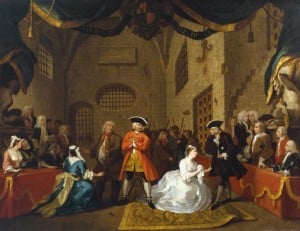 |
| The Beggar’s Opera (www.music.org) |
The Granddaddy of Guys and Dolls and arguably the American Musical, is the 18th century English Ballad Opera, The Beggar’s Opera by John Gay (1728), a rollicking satire on human and social corruption with a gleefully depicted underworld serving as a funhouse mirror of respectable British society.
Gay’s innovation was to reset existing English melodies to new lyrics suitable to his needs. The method surprised and delighted audiences who could come in humming the tunes, undercut the heightened romance, heroic stature, and foreign languages of the dominant grand opera, and overnight established a vogue for vernacular musical entertainments, and the kind of “light” or comic opera that the Victorian team of Gilbert and Sullivan would further immortalize.
Never one to pass on dramatically sound existing material, German playwright Bertolt Brecht returned to Gay’s masterwork in collaboration with composer Kurt Weill for their adaptation entitled The Threepenny Opera. Premiering in 1928, this updated reboot would become one of the most important and influential musicals of the century. Although Brecht and Weill’s piece would fizzle on Broadway in 1933, finding delayed success two decades later in a landmark Off-Broadway production, its appearance in the 20s suggests that the vein of exploiting urbanism, and especially its criminal class for fun and profit was there to be mined.
 |
| (www.threepennyopera.org) The Threepenny Opera (www.last.fm) |
The pointedness of Gay’s outrageousness and Brecht’s politics may be absent in Frank Loesser, but those predecessors would certainly recognize a kinship with their own experiments and the shrewdness of making such subject matter deeply pleasurable. “The proof of the pudding,” Brecht was fond of repeating, “is in the eating,” and Loesser’s audiences, like those of Gay and Brecht/Weill before him, clearly couldn’t get enough. As much as George M. Cohan, George and Ira Gershwin, and Richard Rodgers and Lorenz Hart had earlier in the century, Loesser’s Guys and Dolls would put its indelible stamp on our collective consciousness of what New York City is all about.
 |
| Guys and Dolls (www.playbill.com) |
Thus, if Loesser and Abe Burrows engaged in the ongoing project of reshaping American mythology (the credited Jo Swerling withdrew from the project at an early stage but was contractually protected to be listed co-author), they built not only on the trifecta of Gay, Brecht, and Runyon, but upon another prominent figure of the interwar and postwar years.
Walter Winchell was ubiquitous in newspapers, radio and television from the 30s to the 50s helping popularize the same kind of punchy style and striking use of American idioms which characterized Runyon’s pieces, as well as (for better or worse) fueling the fixation on American celebrity, a focus which has ballooned to today’s gargantuan proportions. Like Runyon, Winchell retailored New York as the glorious, glamorous, gaudy heart of national culture, providing colorful ballast to the dreariness, predictability, and sacrificial ethos endemic to the Depression and the nation’s slow recovery.
 |
| Newsman and personality Walter Winchell offered relief from America’s starker realties. (www.britannica.com) (www.vintage-ads.livejournal.com) |
Given both men’s high-profiles and their special delights, the Runyon-Winchell Manhattan became enshrined as the truth of the times. Their New York City was the bold, brash image the metropolis craved for itself, and consequently internalized as authentic memory. And from the opening sequence entitled “Runyonland”, Loesser and his collaborators recognize how full and loving a portrait of modern America was contained within this potent mix of outsized ambitions, sympathy and cynicism, and a promise of wish-fulfillment.
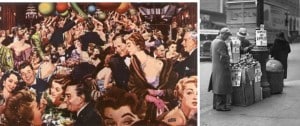 |
| (www.spoonercentral.com) High times and bad times in period New York (www.britannica.com) |
It is this heady air that is so blissfully captured in Guys and Dolls, preserving in equal measure the sentiment and snap of the American life. If transplanting pastoral romance to big city environs wasn’t exactly new, it still felt sincere enough to ring true given the historical moment of Guys and Dolls, coming just before the explosion of the suburbs transformed the national psyche once more.
 |
| (www.blog.insidetheapple.net) (www.mysticstamp.com) |
Guys and Dolls embodies both the hustle and wistful tenderness of the city, a union speaking to the intersection of an abiding faith in American innocence with our parallel drive for greater experience. Sky Masterson’s hymn to the city dweller’s senses of place and self introducing this essay is a disarmingly intimate turn so characteristic of Loesser’s whole. From start to finish his New York City is personified with as much devotion as any character—two of its defining features, the skyline and subway, literal signifiers of those brass rings of aspiration and mobility, the reach and the freedom that built and continue to inspire America. The zip and rush of the contemporary world offset the habit of trading in nostalgia, but Guys and Dolls still finds ample time for quietly reflective moments as in a painting by Edward Hopper. In this fusion, the piece’s emotional power is unforced, organic and satisfyingly earned.
 |
| (www.mercantilemill.com) (www.redditgifts.com) |
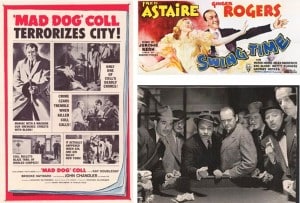 |
| Glitz, gangsters and gamblers rubbing shoulders in Hollywood takes on New York. (www.moviepostershop.com) (www.gettyimages.com) (www.antiquegamblingchips.com) |
What, then, are some of Loesser’s life lessons musicalized in Guys and Dolls? Submitted for your approval is a Lucky 7 of extrapolations:
- If the national character is equal parts passion, optimism and irony, Musical Comedy is one of its most perfect and telling expressions.
- Virtue and vice are inextricably bound in a host of our enduring works, likewise sentiment and satire.
- Similarly, all extremes of morality or sin threaten us with a diminished life. This is nowhere more pronounced than in the turnabouts following the show’s Havana interlude.
- Our history is not one of constant upheaval. A peaceful progress can even be traced between our pastoral past and urban present.
- American success and happiness are just as predicated on luck as on pluck. The Puritan work ethic isn’t everything. Timing and “chemistry” as Sky maintains, are also verities. In that respect, both Plymouth Rock and Las Vegas are key memorials.
- Always take your best shot and err on the side of trust. If not, you might let a sizable windfall or precious chance at love pass you by.
- On the flip side of that last injunction, if a wager seems too good to be true, decline it and happily avoid “an earful of cider”.
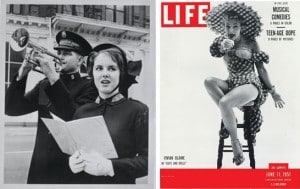 |
| Vitality and Variety: Salvationists and Showgirls sharing Guys and Dolls‘ spotlight. (www.pinterest.com/thesalarmyctri) (www.takemeback.to) |
In these and other respects, Guys and Dolls endures as a musical monument to Whitman-esque ideals, showcasing our nation’s time of day in a one-in-a-million town in which one can’t help but hear and respond to America singing. In any sweepstakes of urban Americana it’s truly better than even money that Guys and Dolls finds a place in the winner’s circle.
 |
| (www.newyork-wallpapers.com) (www.allposters.com) |
Guys & Dolls – onstage through July 25th.
Click here or call 919.962.7529 for tickets or more information.